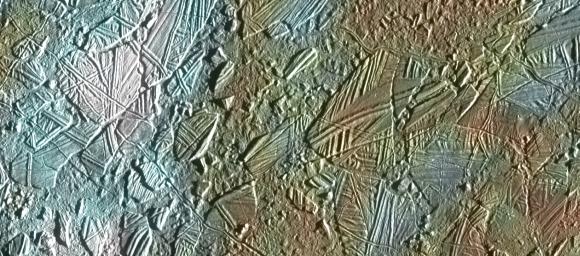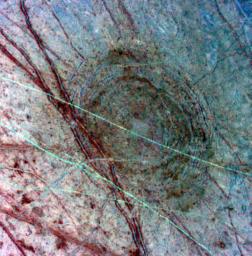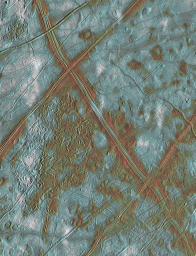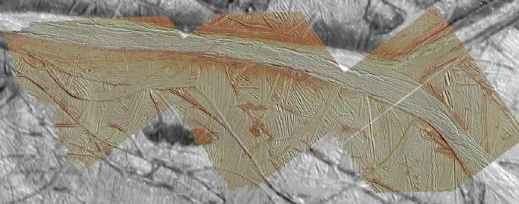
|
These images and other images and data received from Galileo are posted on the World Wide Web, on the Galileo mission home page at galileo.jpl.nasa.gov. Background information and educational context for the images can be found at URL www.jpl.nasa.gov/galileo/sepo.
Below: View of a small region of the thin, disrupted, ice crust in the Conamara region showing the interplay of surface color with ice structures. The white and blue colors outline areas that have been blanketed by a fine dust of ice particles ejected at the time of formation of the 26 kilometer in diameter crater Pwyll some 1000 kilometers to the south.

|
Below: This feature on Europa was seen as a dark, diffuse circular patch on a previous Galileo global image of Europa's leading hemisphere on April 3, 1997. The 'bulls-eye' pattern appears to be a 140- kilometer (86-mile) wide impact scar (about the size of the island of Hawaii) which formed as the surface fractured minutes after a mountain- sized asteroid or comet slammed into the satellite.
The earliest event was the impact which formed the Tyre structure at 34 degrees north latitude and 146.5 degrees west longitude. The impact was followed by the formation of the reddish lines superposed on Tyre. The red color designates areas that are probably a dirty water ice mixture. The fine blue-green lines crossing the region from west to east appear to be ridges which formed after the crater.

|
Below: Features such as domes and ridges, as well as a region of disrupted terrain including crustal plates which are thought to have broken apart and 'rafted' into new positions. The image covers an area of about 250 by 200 kilometer (km). The color information allows the surface to be divided into three distinct spectral units. The bright white areas are ejecta rays from the relatively young crater Pwyll, which is located about 1000 km to the south (bottom) of this image. These patchy deposits appear to be superposed on other areas of the surface, and thus are thought to be the youngest features present. Also visible are reddish areas which correspond to locations where non-ice components are present. This coloring can be seen along the ridges, in the region of disrupted terrain in the center of the image, and near the dome-like features where the surface may have been thermally altered. Thus, areas associated with internal geologic activity appear reddish. The third distinct color unit is bright blue, and corresponds to the relatively old icy plains.

|
Below: Agenor Linea is an unusually bright, white band on Jupiter's icy moon Europa. This mosaic uses color images to "paint" high resolution images of Agenor, and then places the colorized images within lower resolution images of the surrounding area. All data was obtained on September 26th, 1998 during the 17th orbit of Jupiter by NASA's Galileo spacecraft. Along this portion of Agenor is a "triple band," flanked by dark, reddish material of uncertain origin. On the right side of this image, Agenor splits into two sections. These color images will help scientists understand why Agenor Linea is unusually bright and white compared to Europa's other ridges and bands.

|